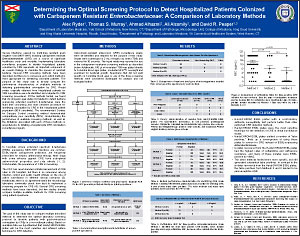Determining the Optimal Screening Protocol to Detect Hospitalized Patients Colonized with Carbapenem Resistant Enterobacteriaceae: A Comparison of Laboratory Methods
Alex Ryder1, Thomas S. Murray1, Ahmad Alhazmi2, Ali Alsomily2, and David R. Peaper1, 3
1Department of Laboratory Medicine, Yale School of Medicine, New Haven, CT; 2Department of Pathology, Microbiology Unit, College of Medicine, King Saud University and King Khalid University Hospital, Riyadh, Saudi Arabia; 3Department of Pathology and Laboratory Medicine, VA Connecticut Healthcare System, West Haven, CT
ABSTRACT
Severe infections caused by multi-drug resistant gram negative rods (MDR-GNR) including carbapenem resistant Enterobacteriaceae (CRE) are a source of significant healthcare costs and mortality. Implementing laboratory surveillance programs to identify hospitalized patients colonized by CRE represents an important component of an overall strategy to minimize the spread of resistant bacteria. Several CRE screening methods have been described, but there is no consensus as to which method is most appropriate for identifying colonized patients. The purpose of this study was to directly compare the performance characteristics of available methods of detecting gastrointestinal colonization by CRE. Rectal swabs originally obtained from hospitalized patients for VRE surveillance were de-identified and subjected to CRE screening procedures. Of the methods tested, we found that chromogenic agar plates formulated to detect bacteria expressing extended spectrum β-lactamases were the least time consuming and most sensitive procedure for identifying colonization by CRE in this hospitalized patient population (80% sensitivity). The recommended Centers for Disease Control screening method demonstrated comparatively poor sensitivity (60%). Understanding the performance of available screening methods, as well as the limitations associated with each of these methods, is essential prior to initiating a hospital wide CRE colonization surveillance program.
©2012 Yale Department of Pathology. All rights reserved.
Any redistribution or reproduction of part or all of the contents in any form is prohibited. You may not, except with express written permission of the author or the Department of Pathology, distribute or commercially exploit the content, nor may you transmit it or store it in any other website or other form of electronic retrieval system, including use for educational purposes.
